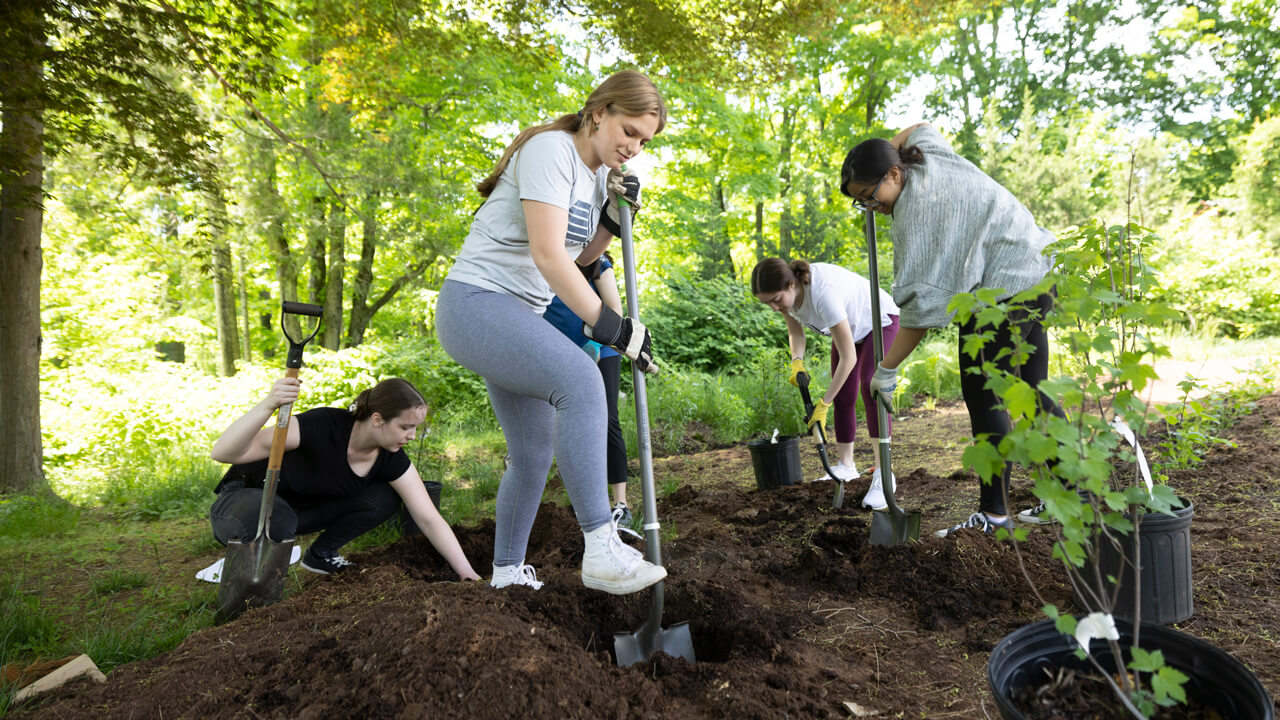87% Flowering Plants
An estimated 87% of all flowering plants rely on animal pollinators*



Sustainability
The pollinator garden at Quinnipiac's Albert Schweitzer Institute provides food and shelter to a wide range of local pollinators, promoting a healthy ecosystem. Beyond these organisms, the pollinator garden provides opportunities for research, education and positive well-being in the greater Bobcat community.
Pollinators facilitate the reproduction of plants and strengthen diversity within ecosystems. Pollinators provide services to 180,000 different plant species, including more than 1,200 crops. It is estimated that pollinators contribute over $217 billion to the global economy.1
Most pollinator populations have been drastically declining due to a variety of reasons, including habitat loss, pesticide use, disease, invasive species and climate change.2
Pollinator gardens contain various native or native cultivars that produce nectar and/or pollen. These gardens increase pollinator occupancy and help main healthy ecosystems by setting up optimal pollination conditions.‡
The pollinator garden at Quinnipiac was designed with help from Natureworks Garden Center in North Branford, Connecticut. The garden consists of six themed beds encompassing over 200 species of native plants or native cultivars. Students assist with the maintenance of the gardens, and they are researching and creating educational displays for each.
The bee garden is used as a sanctuary and source of nectar for bees to thrive. This bed contains a variety of plants that bees are drawn to, supporting them to carry out their ecological role in pollination. Plants found in this garden include bee balms (Monarda didyma), zinnia (Zinnia elegans), stonecrop (Sedum spp.), and foxglove beardtongue (Penstemon digitalis).
The butterfly garden focuses on plants used as a food source for either larval (caterpillars) or adult lepidopteran (moths and butterflies). This garden includes wild lupine (Lupinus perennis), purple coneflower (Echinacea purpurea), and blazing star (Liatris scariosa).
The Indigenous people’s perennial and shrub garden focuses on plants used by indigenous people in the area either as food or medicine. Working with the Indigenous Student Union, we have designed a section dedicated specifically to the plants used by the Mohegan tribe, including common boneset (Eupatorium perfoliatum), wild indigo (Baptisia tinctoria), and sweet fern (Comptonia peregrina).
The rain garden is planted in a depression to allow for rain and storm water runoff reabsorption by the soil. The plants in this section of the garden are adapted to both dry and wet soil conditions. Some plants in this section include Culver's root (Veronicastrum virginicum), Northern blue flag (Iris versicolor) and White Cloud Calamint (Calamintha nepeta).
The rainbow successional garden is organized by color, like a rainbow, and has plants blooming in succession from April to September. A successional garden provides food resources for pollinators throughout the growing season. This garden is occupied with a variety of colorful plants, including bee balm (Monarda didyma), black-eyed susan (Rudbeckia hirta), smooth aster (Symphytrichum laeve), Virginia bluebells (Mertensia virginica), and butterfly milkweed (Asclepias tuberosa).
The shade garden contains plants that require minimal sunlight exposure to grow. They are adapted to carry out photosynthesis with their large surface area leaves and can be used as a shelter for many organisms to reproduce. Plants found in this garden include coral bells (Heuchera spp.), wild ginger (Asarum canadense), foamflower (Tiarella cordifolia) and Jacob’s Ladder (Polemonium reptans).
We envision a Quinnipiac that is a model for sustainability in Southern New England, building its practices and leveraging its campuses to promote a healthy regional ecosystem, and to engage in practices that equip current and future students, faculty and staff to embody sustainable practices in their personal and professional lives, equipping them to thrive in a world increasingly influenced and affected by environmental disruption.
Students for Environmental Action (SEA) is a club committed to promoting environmental stewardship at Quinnipiac and in the broader community. Past events include World Environment Health Day and fundraising for the Coral Sea Alliance. If you are interested in participating in sustainability initiatives around campus with a group of like-minded environmentalists, consider joining SEA.
The Albert Schweitzer Institute conducts programs that link education, ethics and voluntarism for the sake of creating a more peaceful and sustainable world. A dynamic presence at Quinnipiac, the institute has drawn notable humanitarians both to campus and to its board, and gives students of all majors opportunities to make a positive impact on local and global communities.
1 Gallai N, Salles JM, Settele J, Vaissiere BE (2009) Economic valuation of the vulnerability of world agriculture confronted with pollinator decline. Ecological Economics 68:810–821
2 National Research Council of the National Academies (2006) Status of Pollinators in North America. National Academy Press, Washington, DC.
* Ollerton J, Winfree R, Tarrant S. 2011. How many flowering plants are pollinated by animals? Oikos 120:312-326.
^ Ponisio LC, M’Gonigle LK, Mace KC, Palomino J, de Valpine P, Kremen C. 2015. Diversification practices reduce organic to conventional yield gap. Proc R Soc B 282:20141396.
† Howarth M, Brettle A, Hardman M, Maden M. What is the evidence for the impact of gardens and gardening on health and well-being: a scoping review and evidence-based logic model to guide healthcare strategy decision making on the use of gardening approaches as a social prescription. BMJ Open. 2020 Jul 19;10(7):e036923. doi: 10.1136/bmjopen-2020-036923. PMID: 32690529; PMCID: PMC7371129.
‡ Frankie GW, Thorp RW, Hernandez JL, Rizzardi M, Ertter B, Pawelek JC, Witt SL, Schindler M, Coville R, Wojcik VA (2009) Native bees are a rich natural resource in urban California gardens. California Agriculture 63:113–120